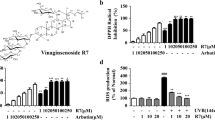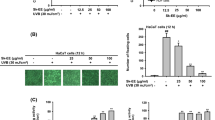Abstract
Icariin (ICA) and icaritin (ICT) exhibit many pharmacological functions including anti-osteoporosis, anti-cardiovascular, and anti-cancer activities; however, there are few comprehensive studies that track the detailed effects on UVB-induced photoaging. The recovery effects of ICA and ICT were investigated in UVB-irradiated human keratinocytes (HaCaTs). The results indicated that ICT and ICA showed strong radical scavenging activity, and the reactive oxygen species (ROS) scavenging activity of ICT was superior. UVB-induced matrix metalloproteinase-1 (MMP-1) expression was blocked by ICA via the inhibition of mitogen-activated protein kinase/activator protein 1 (MAPK/AP-1), which directly reduced extracellular matrix (ECM) degradation. ICT activated nuclear factor erythroid 2 related factor 2 (Nrf2) to improve the anti-oxidative stress capacity and suppress nuclear factor-κB (NF-κB) activation, decreasing vascular endothelial growth factor (VEGF) protein, and inflammatory cytokines induced ECM degrading enzyme secretion. Moreover, ICT was more advantageous to improve transforming growth factor beta 1 (TGF-β1) and procollagen type I expression than ICA, promoting the synthesis of collagen. Therefore, ICA and ICT have potential to treat UVB-induced oxidative stress, inflammation and photoaging, and will be posited as a novel strategy to alleviate photodamage.
Similar content being viewed by others
Change history
27 October 2020
A Correction to this paper has been published: https://doi.org/10.1039/c8pp90048e
References
S. K. Katiyar, UV-induced immune suppression and photocarcinogenesis: chemoprevention by dietary botanical agents, Cancer Lett., 2007, 255, 1–11.
A. T. Dinkova-Kostova, Phytochemicals as protectors against ultraviolet radiation: versatility of effects and mechanisms, Planta Med., 2008, 74, 1548–1559.
N. A. Bonekamp, A. Völkl, H. D. Fahimi, M. Schrader, Reactive oxygen species and peroxisomes: struggling for balance, Biofactors, 2009, 35, 346–355.
M. B. Y. Greenwald, M. Frušić-Zlotkin, Y. Soroka, S. Ben-Sasson, H. Bianco-Peled, R. Kohen, A novel role of topical iodine in skin: activation of the Nrf2 pathway, Free Radical Biol. Med., 2017, 104, 238–248.
N. Wakabayashi, S. L. Slocum, J. J. Skoko, S. Shin, T. W. Kensler, When NRF2 talks, who's listening?, Antioxid. Redox Signaling, 2010, 13, 1649–1663.
U. Panich, G. Sittithumcharee, N. Rathviboon, S. Jirawatnotai, Ultraviolet radiation-induced skin aging: the role of DNA damage and oxidative stress in epidermal stem cell damage mediated skin aging, Stem Cells Int., 2016, 2016, 1–14.
A. T. Dinkova-Kostova, A. Y. Abramov, The emerging role of Nrf2 in mitochondrial function, Free Radical Biol. Med., 2015, 88, 179–188.
Z. W. Sun, S. Y. Park, E. Hwang, M. Y. Zhang, S. A. Seo, P. Lin, T. H. Yi, Thymus vulgaris alleviates UVB irradiation induced skin damage via inhibition of MAPK/AP-1 and activation of Nrf2-ARE antioxidant system, J. Cell. Mol. Med., 2017, 21, 336–348.
Z. W. Sun, S. Y. Park, E. Hwang, B. Park, S. A. Seo, J. G. Cho, M. Y. Zhang, T. H. Yi, Dietary Foeniculum vulgare Mill extract attenuated UVB irradiation-induced skin photoaging by activating of Nrf2 and inhibiting MAPK pathways, Phytomedicine, 2016, 23, 1273–1284.
V. Muthusamy, T. J. Piva, The UV response of the skin: a review of the MAPK, NF-κB and TNF-α signal transduction pathways, Arch. Dermatol. Res., 2010, 302, 5.
F. Guadagni, P. Ferroni, R. Palmirotta, I. Portarena, V. Formica, M. Roselli, TNF/VEGF cross-talk in chronic inflammation-related cancer initiation and progression: an early target in anticancer therapeutic strategy, In vivo, 2007, 21, 147–161.
M. S. Kim, Y. K. Kim, H. C. Eun, K. H. Cho, J. H. Chung, All-trans retinoic acid antagonizes UV-induced VEGF production and angiogenesis via the inhibition of ERK activation in human skin keratinocytes, J. Invest. Dermatol., 2006, 126, 2697–2706.
J. Zhang, W. Ma, Nerve growth factor regulates the expression of vascular endothelial growth factor in human HaCaT keratinocytes via PI3K/mTOR pathway, Genet. Mol. Res., 2014, 13, 9324–9335.
M. Wlaschek, I. Tantcheva-Poór, L. Naderi, W. Ma, L. A. Schneider, Z. Razi-Wolf, J. Schüller, K. Scharffetter-Kochanek, Solar UV irradiation and dermal photoaging, J. Photochem. Photobiol., B, 2001, 63, 41–51.
S. R. Pinnell, Cutaneous photodamage, oxidative stress, and topical antioxidant protection, J. Am. Acad. Dermatol., 2003, 48, 1–22.
T. Quan, Z. Qin, W. Xia, Y. Shao, J. J. Voorhees and G. J. Fisher, Matrix-degrading metalloproteinases in photoaging, In. J. Invest. Dermatol. Symp. Proc., Elsevier, 2009.
F. Luchetti, M. Betti, B. Canonico, M. Arcangeletti, P. Ferri, F. Galli, S. Papa, ERK MAPK activation mediates the antiapoptotic signaling of melatonin in UVB-stressed U937 cells, Free Radical Biol. Med., 2009, 46, 339–351.
M. Cargnello, P. P. Roux, Activation and function of the MAPKs and their substrates, the MAPK-activated protein kinases, Microbiol. Mol. Biol. Rev., 2012, 76, 496.
M. J. Piao, R. Zhang, N. H. Lee, J. W. Hyun, Phloroglucinol attenuates ultraviolet B radiation-induced matrix metalloproteinase-1 production in human keratinocytes via Inhibitory actions against mitogen-activated protein kinases and activator protein-1, Photochem. Photobiol., 2012, 88, 381–388.
K. C. Kim, S. S. Kang, J. Lee, D. Park, J. W. Hyun, Baicalein attenuates oxidative stress-induced expression of matrix metalloproteinase-1 by regulating the ERK/JNK/AP-1 pathway in human keratinocytes, Biomol. Ther., 2012, 20, 57.
G. J. Fisher, S. C. Datta, H. S. Talwar, Z. Q. Wang, J. Varani, S. Kang, J. J. Voorhees, Molecular basis of sun-induced premature skin ageing and retinoid antagonism, Nature, 1996, 379 (6563), 335.
F. Verrecchia, A. Mauviel, Control of connective tissue gene expression by TGFβ: role of Smad proteins in fibrosis, Curr. Rheumatol. Rep., 2002, 4, 143–149.
X. Q. Lai, Y. X. Ye, C. H. Sun, X. Y. Huang, X. G. Tang, X. F. Zeng, P. H. Yin, Y. Y. Zeng, Icaritin exhibits anti-inflammatory effects in the mouse peritoneal macrophages and peritonitis model, Int. Immunopharmacol., 2013, 16, 41–49.
H. P. Ma, X. N. Ma, B. F. Ge, P. Zhen, J. Zhou, Y. H. Gao, C. J. Xian, K. M. Chen, Icariin attenuates hypoxia-induced oxidative stress and apoptosis in osteoblasts and preserves their osteogenic differentiation potential in vitro, Cell Proliferation, 2014, 47, 527–539.
F. Zhao, Y. Z. Tang, Z. Q. Liu, Protective effect of icariin on DNA against radical-induced oxidative damage, J. Pharm. Pharmacol., 2007, 59, 1729–1732.
W. Zhang, B. C. Xing, L. L. Yang, J. L. Shi, X. M. Zhou, Icaritin attenuates myocardial ischemia and reperfusion injury via anti-inflammatory and anti-oxidative stress effects in rats, Am. J. Chin. Med., 2015, 43, 1083–1097.
S. L. Peng, G. Zhang, B. T. Zhang, B. S. Guo, Y. X. He, A. J. Bakker, X. H. Pan, W. X. Zhen, L. K. Hung, L. Qin, The beneficial effect of icaritin on osteoporotic bone is dependent on the treatment initiation timing in adult ovariectomized rats, Bone, 2013, 55, 230–240.
Z. Q. Wang, X. N. Zhang, H. Wang, L. Qi, Y. Lou, Neuroprotective effects of icaritin against beta amyloid-induced neurotoxicity in primary cultured rat neuronal cells via estrogen-dependent pathway, Neurosci., 2007, 145, 911–922.
Y. X. Fu, C. Y. Liu, M. J. Guo, Y. Zhao, F. X. Jin, H. S. Yu, Bioconversion utilization of waste-residue from icarrin extraction, J. Food Sci. Technol., 2017, 38, 167–177.
Y. S. Wang, J. G. Cho, E. Hwang, J. E. Yang, W. Gao, M. Z. Fang, S. D. Zheng, T. H. Yi, Enhancement of protective effects of Radix Scutellariae on UVB-induced photodamage in human HaCaT keratinocytes, Appl. Biochem. Biotechnol., 2018, 184, 1073–1093.
E. Hwang, H. T. Ngo, B. Park, S. A. Seo, J. E. Yang, T. H. Yi, Myrcene, an aromatic volatile compound, ameliorates human skin extrinsic aging via regulation of MMPs production, Am. J. Chin. Med., 2017, 1–12.
M. Liu, H. P. Liu, X. M. Lu, C. Li, Z. L. Xiong, F. M. Li, Simultaneous determination of icariin, icariside II and osthole in rat plasma after oral administration of the extract of Gushudan (a Chinese compound formulation) by LC-MS/MS, J. Chromatogr. B: Anal. Technol. Biomed. Life Sci., 2007, 860, 113–120.
Z. H. Li, D. Alex, S. O. Siu, I. K. Chu, J. Renn, C. Winkler, S. Lou, S. K. W. Tsui, H. Y. Zhao, W. R. Yan, Combined in vivo imaging and omics approaches reveal metabolism of icaritin and its glycosides in zebrafish larvae, Mol. BioSyst., 2011, 7, 2128–2138.
S. Pillai, C. Oresajo, J. Hayward, Ultraviolet radiation and skin aging: roles of reactive oxygen species, inflammation and protease activation, and strategies for prevention of inflammation-induced matrix degradation-a review, Int. J. Cosmet. Sci., 2005, 27, 17–34.
J. Y. Kim, Y. N. Cha, Y. J. Surh, A protective role of nuclear factor-erythroid 2-related factor-2 (Nrf2) in inflammatory disorders, Mutat. Res., 2010, 690, 12–23.
Y. R. Xu, G. J. Fisher, Ultraviolet (UV) light irradiation induced signal transduction in skin photoaging, J. Dermatol. Sci., Suppl., 2005, 1, S1–S8.
A. Hirota, Y. Kawachi, M. Yamamoto, T. Koga, K. Hamada, F. Otsuka, Acceleration of UVB-induced photoageing in nrf2 gene-deficient mice, Exp. Dermatol., 2011, 20, 664–668.
A. R. Han, M. H. Nam, K. W. Lee, Plantamajoside inhibits UVB and advanced glycation end products-induced MMP-1 expression by suppressing the MAPK and NF-κB pathways in HaCaT cells, Photochem. Photobiol., 2016, 92, 708–719.
R. Craig, A. Larkin, A. M. Mingo, D. J. Thuerauf, C. Andrews, P. M. McDonough, C. C. Glembotski, p38 MAPK and NF-κB collaborate to induce interleukin-6 gene expression and release evidence for a cytoprotective autocrine signaling pathway in a cardiac myocyte model system, J. Biol. Chem., 2000, 275, 23814–23824.
B. Porée, M. Kypriotou, C. Chadjichristos, G. Beauchef, E. Renard, F. Legendre, M. Melin, S. Gueret, D. J. Hartmann, F. Malléin-Gerin, Interleukin-6 (IL-6) and/or soluble IL-6 receptor down-regulation of human type II collagen gene expression in articular chondrocytes requires a decrease of Sp1· Sp3 ratio and of the binding activity of both factors to the COL2A1 promoter, J. Biol. Chem., 2008, 283, 4850–4865.
P. Greenwel, S. Tanaka, D. Penkov, W. Zhang, M. Olive, J. Moll, C. Vinson, M. Di Liberto, F. Ramirez, Tumor necrosis factor alpha inhibits type I collagen synthesis through repressive CCAAT/enhancer-binding proteins, Mol. Cell. Biol., 2000, 20, 912–918.
Y. Jia, J. J. Turek, Inducible nitric oxide synthase links NF-κB to PGE 2 in polyunsaturated fatty acid altered fibroblast in vitro wound healing, Lipids Health Dis., 2005, 4, 14.
P. Wäster, I. Rosdahl, K. Öllinger, Cell fate regulated by nuclear factor-κB-and activator protein-1-dependent signalling in human melanocytes exposed to ultraviolet A and ultraviolet B, Br. J. Dermatol., 2014, 171, 1336–1346.
H. B. Schonthaler, R. Huggenberger, S. K. Wculek, M. Detmar, E. F. Wagner, Systemic anti-VEGF treatment strongly reduces skin inflammation in a mouse model of psoriasis, Proc. Natl. Acad. Sci. U. S. A., 2009, 106, 21264–21269.
N. Linde, W. Lederle, S. Depner, N. Van Rooijen, C. M. Gutschalk, M. M. Mueller, Vascular endothelial growth factor-induced skin carcinogenesis depends on recruitment and alternative activation of macrophages, J. Pathol., 2012, 227, 17–28.
S. Hirakawa, S. Fujii, K. Kajiya, K. Yano, M. Detmar, Vascular endothelial growth factor promotes sensitivity to ultraviolet B-induced cutaneous photodamage, Blood, 2005, 105, 2392–2399.
J. F. Wu, J. Du, X. Q. Fu, B. Liu, H. H. Cao, T. Li, T. Su, J. H. Xu, A. K. W. Tse, Z. L. Yu, Icaritin, a novel FASN inhibitor, exerts anti-melanoma activities through IGF-1R/STAT3 signaling, Oncotarget, 2016, 7, 51251.
Y. T. Chen, R. L. Zheng, Z. J. Jia, Y. Ju, Flavonoids as superoxide scavengers and antioxidants, Free Radical Biol. Med., 1990, 9, 19–21.
N. Cotelle, J. L. Bernier, J. P. Catteau, J. Pommery, J. C. Wallet, E. M. Gaydou, Antioxidant Properties of Hydroxy-flavones, Free Radical Biol. Med., 2005, 39, 1284.
D. Amić, D. Davidović-Amić, D. Bešlo, N. Trinajstić, Structure-radical scavenging activity relationships of flavonoids, Croat. Chem. Acta, 2003, 76, 55–61.
Acknowledgments
This work was supported by the TAEYI Life Science Co. Ltd., Republic of Korea. We thank Professor Hong-Shan Yu (College of Biotechnology, Dalian Polytechnic University, Dalian, China) for reagents and technical supports.
Author information
Authors and Affiliations
Corresponding author
Rights and permissions
About this article
Cite this article
Hwang, E., Lin, P., Ngo, H.T.T. et al. Icariin and icaritin recover UVB-induced photoaging by stimulating Nrf2/ARE and reducing AP-1 and NF-κB signaling pathways: a comparative study on UVB-irradiated human keratinocytes. Photochem Photobiol Sci 17, 1396–1408 (2018). https://doi.org/10.1039/c8pp00174j
Received:
Accepted:
Published:
Issue Date:
DOI: https://doi.org/10.1039/c8pp00174j




